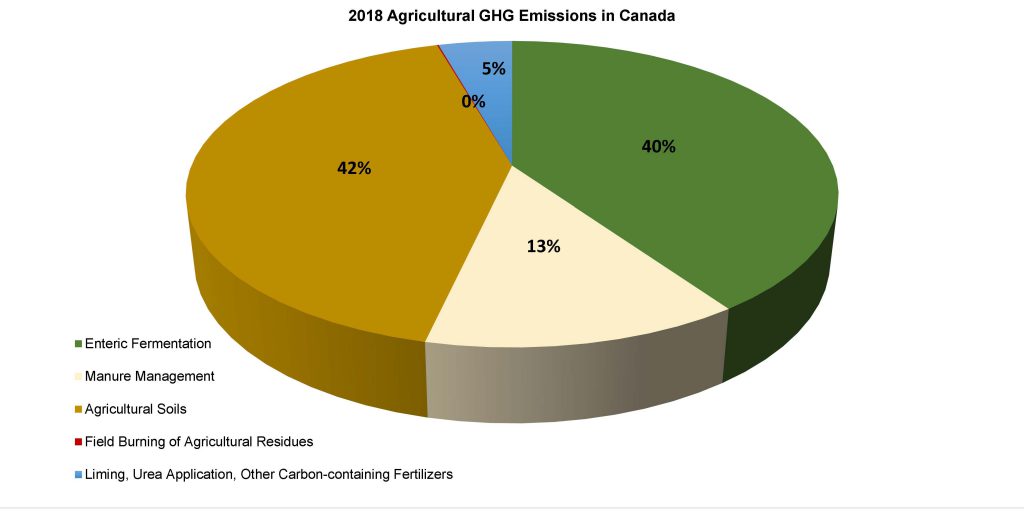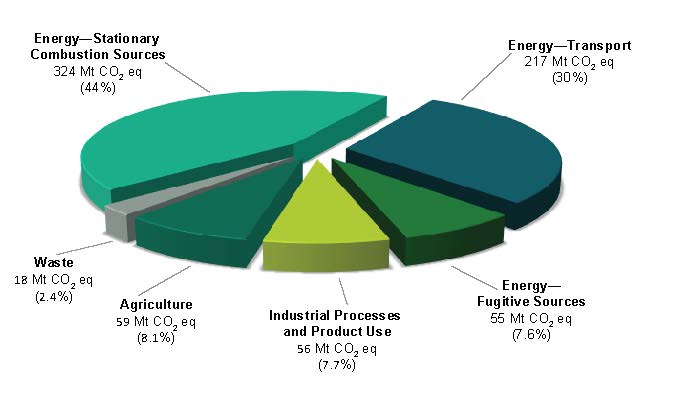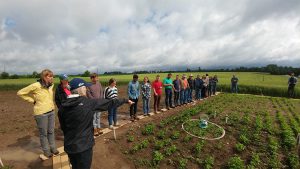Greenhouse gases in agriculture
UNDERSTANDING EMISSIONS

WHILE GREENHOUSE GASES (ghg) are essential to making life on earth possible through the greenhouse effect, increased GHG levels in our atmosphere can have detrimental impacts. As a result, stronger emphasis has been placed on tracking our GHG emissions and the sources of these emissions. It is well known that around the world, GHG emissions are constantly being generated through a variety of processes, practices, and industries. The inability to accurately track GHG emissions prevents us from better understanding where our impacts lie.
Recently, the global agriculture sector has been looked at as a key contributor to GHG emissions. But exactly how is the agriculture sector contributing and what does this look like in Canada? In order to understand impact, we need to understand how the agricultural sector is emitting.

CANADA’S EMISSIONS
Canada’s National Inventory Report as reported by the Government of Canada tracks and reports Canada’s GHG emissions across sectors. As reported in 2018, Canada produced 729 megatonnes of carbon dioxide equivalent (Mt of CO2 eq). A megatonne is a universal unit of measure used for describing GHG emissions. One megatonne of carbon dioxide is equal to what 250,000 cars produce each year. With that said, in 2018 Canada produced the equivalents of 182 million cars worth of carbon dioxide. Canada has taken action with commitments made to reduce our GHG emissions. After signing on to the Paris Agreement, which is an international framework that looks to combat climate change, Canada has committed to reducing its GHG emissions by 30 per cent below 2005 levels by 2030.
THE AGRICULTURAL SECTOR
In Canada, the agricultural industry is responsible for several processes that emit GHGs into our environment. As noted within the 2018 report, the agricultural sector is responsible for 59 Mt of CO2 equivalents or 8.1 per cent of Canada’s total GHG emissions. It should be noted for this calculation, the agriculture sector covers non-energy GHG emissions relating to the production of crops and livestock.
The report divides agricultural emissions into five main sources as it relates to non-energy GHG emissions through the production of crops and livestock. These include enteric fermentation; manure management; agricultural soils; liming, urea application and other carbon-containing fertilizers; and field burning of agricultural residues. The main GHGs emitted from Canada’s agriculture industry are nitrous oxide (N2O), methane (CH4), and carbon dioxide (CO2).

Nitrous Oxide (N2O)
N2O emissions have a significant impact on the warming of the atmosphere. It can be equated that N2O has about 300 times the warming potential to that of CO2. While N2O is naturally occurring in the environment, agriculture is both a direct and indirect contributor to these emissions. In 2018, agriculture accounted for 76 per cent of Canada’s total N2O emissions. Agricultural soils naturally emit N2O and direct N2O emissions occur from nitrogen fertilizer applications including manure and fertilizer. N2O emissions are also available following the decomposition of crop residue. Indirect emissions come from leaching and runoff, as well as volatilization.
Methane (CH4)
Methane (CH4) from agricultural activities also contributes to GHG emissions, mainly through livestock and their manure. It can be equated that CH4 has 25 times the warming potential to that of CO2. In 2018, agriculture accounted for 31 per cent of Canada’s total CH4 emissions. The two main ways CH4 is emitted is through enteric fermentation and manure management. Enteric fermentation is where methane emissions are mainly produced through the normal digestive processes in animals. Whereas, manure management is where methane is produced by the anaerobic decomposition of manure.
Carbon dioxide (CO2)
Carbon dioxide (CO2) from agricultural activities come from a variety of sources. CO2 can be emitted from the burning of crop residues, regular plant respiration, natural plant decay and decomposition, or through soil carbon loss. However, CO2 can be absorbed by plants through photosynthesis, which can then be sequestered in the soil. Soil carbon is an area that plays a significant contribution within the agricultural industry and can be strongly influenced by the change in the proportion of annual and perennial crops, change in tillage practices, and change in the area of summer fallow. Despite not being included within the agricultural sector in Canada’s National Inventory Report, CO2 is also emitted through fuel combustion within a tractor, dryer, or truck.
The reality is that agriculture does result in GHG emissions but not to the magnitude of other sectors. However, agriculture is a unique sector as the primary emissions come from nitrous oxide and methane. With different climates, soil types, type of crop or vegetation cover, livestock and management practices, GHG emissions can vary from a farm level.
This speaks to the complexity of the topic and that a one-size-fits-all approach is unlikely when trying to achieve GHG emissions mitigation and adaptation strategies.
Michael Buttenham is Grain Farmers of Ontario’s sustainability and environment coordinator.
This article contains analysis from Grain Farmers of Ontario’s market development department. •


























